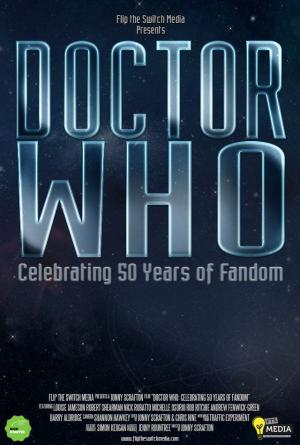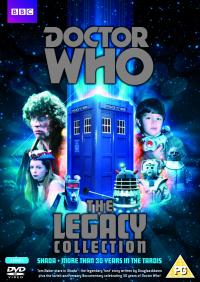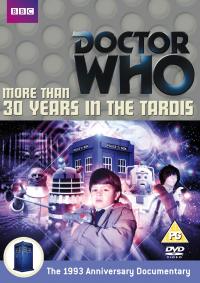Doctor Who: The Complete Series 10
Written by: Steven Moffat, Frank Cottrell-Boyce, Sarah Dollard, Mike Bartlett, Jamie Mathieson, Toby Whithouse, Mark Gatiss, Rona Munro, Peter Harness
Directed by: Rachel Talalay, Lawrence Gough, Bill Anderson, Charles Palmer, Daniel Nettheim, Wayne Yip, Ed Bazzalgette
Starring:
Peter Capaldi (The Doctor), Pearl Mackie (Bill Potts), Matt Lucas (Nardole), Michelle Gomez (Missy), John Simm (The Master), Stephanie Hyam (Heather), Nicholas Briggs (Voice of the Cybermen), Tim Bentinck (Voice of the Monks), Jennifer Hennessey (Moira), Ronke Adekoluejo (Penny), Justin Chatwin (Grant/The Ghost), David Suchet (The Landlord), Nicholas Burns (Lord Sutcliffe)
The Fan Show presented by: Christel Dee
Format: DVD, Blu-Ray
Duration: 10hrs 15mins
BBFC Classifaction: 12
Executive Producers: Steven Moffat, Brian Minchin
Originally Released: November 2017
It’s a tribute to the flexibility of Doctor Who that though these episodes represent the end of an era both before and behind the camera, they feel as fresh, if not fresher than the show has in years. As beloved as she was to many, after three seasons of Clara it was time for a new dynamic and, importantly, a companion specifically tailored to emphasize and complement the strengths of Peter Capaldi’s Doctor. In Bill Potts (Pearl Mackie), always questioning, always sincere, always learning, the Twelfth Doctor received the perfect student to his shock-haired professor. The presence of Nardole (Matt Lucas) in the mix adds to the sense of this being something new. We’ve had TARDIS Trios before, but the previous pattern has largely been the Doctor’s own companion (Rose, Amy) gaining a companion of their own (Mickey, Rory). Nardole’s mix of a loyal manservant and nagging prison guard – hectoring the Doctor to keep to his vow – is something we haven’t seen before. The dynamic between the three is charming and funny and, nicely, the writing team avoids the obvious route of making Nardole antagonistic to new girl Bill. Instead, as much as he disapproves of the Doctor putting them all in danger to show off to Bill, he regards her as entirely blameless and is always kind and protective towards her.
Lucas and Mackie prove themselves more than equal to the challenge of the scripts. Although she was an established theatre actor, the mix of pluck, innocence and pure emotion Mackie brings to Bill is all the more remarkable considering that by the end of her first day working on Series 10 she had more than doubled her entire time on a set up until that point. Lucas, for his part, proves a clever actor, adept at judging a line of a scene and the extras make clear that a lot more goes into his approach than to simply steal every scene with ad-libs.
But without a doubt, this season belongs to Peter Capaldi. For an actor leaving the role because he fears he was running out of new ways of doing it, it's the mercurial, ever-evolving nature of his Doctor which astonishes most. Back in 2014, echoing the approach to the Sixth Doctor by making the Twelfth initially prickly and difficult so he could mellow over time was a high-risk policy. But the 2017 series entirely validates the idea, with the concept of Capaldi's Doctor as someone who only likes to think of himself as cold and aloof, but is actually an exposed nerve of love and anger giving us not only some interesting story possibilities but opportunities for some of the most compelling performances of any actor to play the Doctor.
After Series 9's barnstorming "Call this a war?!" speech, and the bravura one-man show of Heaven Sent, you wouldn't have been blamed for thinking the Doctor Who slot in Capaldi's showreel for his inevitable Lifetime Achievement Awards had been taken, yet the raw emotion of his pleading "Because it's kind" speech in The Doctor Falls gives them a run for their money. While elsewhere, he can speak entire novels without a word when asked if he can even remember how many people he's killed in Thin Ice. But most impressive is the continuity of character - there's never a sense of an actor changing gears as the Twelfth Doctor flits between passionate academic ("TARDIS... It means LIFE!") to ironic asides to towering rages.
This relationship between these three leads fits perfectly with the setup for the new series. The decision to make the Doctor a professor at Bristol University is genius. It gives the excuse for a number of the type of nerve shiveringly perfect monologues Peter Capaldi does so well, disguised as college lectures and echoes Rose’s introduction of “the War” as a mysterious event that’s scarred the Doctor since we last saw him? Why has he lived in exile on Earth for half a century? Is it self-imposed? What’s in the Vault? This last question also provides a shakeup of modern Doctor Who’s formula for series arcs. Usually, some keyword or hint is scattered through the scripts, the significance to be revealed in the finale. Or, alternatively, the Doctor is faced with some puzzle and then sets out to… put off solving it until his Plot Alarm Clock hits “Series Finale.” Here the mystery isn’t spun out for too long and instead replaced midway by a new one: is Missy (Michelle Gomez) really reformed? And the answer to that itself turns out to satisfyingly untidy and an opportunity to show not just how gloriously mad Gomez can be, but how great a dramatic actor she can be.
Meanwhile, though the arc may not reach the extent of serialization of something like The Walking Dead or Jessica Jones, there’s no doubt that the standard Doctor Who notion of ‘one parters’ or ‘two parters’ breaks down this season. This sense of a narrative flowing and building from one episode to the next makes Series 10 a genuinely fresh feeling and exciting ride. The building of the Doctor’s wanderlust, the recklessness that borders of death wish that comes with it, and the resulting consequences define the whole strand of episodes from Oxygen to The Lie of the Land which then segue effortlessly into the revelation of Missy and the Doctor’s deep need to believe she can change.The individual episodes soar to meet the quality of the arc, like the wit and fun of The Pilot, and the insanity and claustrophobia of Oxygen, and the meditations of how small random mistakes can so easily build to a nightmare in The Pyramid at the End of the World, while the final two-parter possibly finally gives the body horror of the Cyberman concept the treatment it deserves, Series 10 hits several highs. It’s a testament to this high bar that even the worst story of the series, Knock Knock, is merely a bit ordinary compared to the others rather than actively poor.
Extras
While sadly the days of commentaries on every episode appear to be long gone now, the three we get here are both witty and informative. Writers Steven Moffat, Mike Bartlett, and Jamie Mathieson provide insight into how their scripts reached their final form, with Pearl Mackie and Matt Lucas on hand with their own tales from the sets of The Pilot and Oxygen, and balance between being engaging and funny company with showing a genuine interest in the writing process and the roads untaken in the versions of the scripts they might have performed in. Director Bill Anderson appears on the commentary for Knock, Knock and the unique challenges that shoot provided. Good as these commentaries are, the reduced number means there’s less scope for hearing from a greater variety of departments.
That slack is taken up, somewhat, by Doctor Who: The Fan Show – The Aftershow (as host Christel Dee herself admits in the first episode, a mouthful of a title) which manages to give a voice for everybody from costume designers to prosthetics artists, as well as guest stars as varied as David Suchet or man-behind-the-Monks Jamie Hill. While episodes such as Matt Lucas and Mark Gatiss’ hilarious, and slightly naughty, ramble around the houses of every question, and Steven Moffat’s in-depth interview about the final two-parter, are genuine highlights of the entire box set.
Christel makes for a charming and personable host, so adept at making you feel like you’re simply sitting with her having a lively chat about Doctor Who in her front room that fans meeting her at conventions probably take a moment to remember they’ve never actually met her. Yet with The Fan Show also freely available online (and indeed, in a longer form than presented here) giving over an entire disc to it does feel a little pointless – except, perhaps, as future proofing for generations to come in case YouTube ever goes the way of AOL Online.
Elsewhere, Becoming the Companion delves into the process of casting an excited, and slightly daunted, Pearl Mackie and follows through her early days of being announced and starting work on set. It’s bookended at the other end of the series by twin documentaries The Finale Falls and The Finale Countdown, which present a similarly excited, and also slightly fraught, Steven Moffat as he scrambles to the finish line to get The Doctor Falls finished with only days left before broadcast. But the Inside Look which accompanies each episode is eminently dispensable – not only the fluffiest of fluff but obviously created as teases to be shown to people who haven’t yet seen the related episode. And how many of those will have bought the box set, let alone watch the extras about an episode before the episode itself?
Packaging and Presentation
The most inexplicable thing about this set is the absence of any way to tell which episodes or special features are on each disc. There’s no insert sheet or booklet with a listing and, even as a cost-saving measure, it makes no sense for the usual listing printed on the disc art to have been dispensed with. Fortunately, thanks to Matthew Purchase, a fanmade insert is available and downloadable here:
The DVD box itself is a slimline sort and though some complain they find the format flimsy, it’s sturdy enough for me and sits more tidily on the shelf. The cover art is striking and takes a greater risk than simply placing a previously released promo photo on the cover. Even better, the Blu-Ray Steelbook has typically stunning art by the dependably brilliant Alice X. Zhang.


 This review is based on a preview of the UK Region 2 DVD, which is
This review is based on a preview of the UK Region 2 DVD, which is  There are two versions of the story to choose from on the disc, the 'reconstruction' presentation of the original
There are two versions of the story to choose from on the disc, the 'reconstruction' presentation of the original  It is perhaps fitting that the 'definitive' celebration of Doctor Who in the 20th Century is on one of the final of the original releases in the Classic DVD range for the 21st - in many ways it the the forerunner of all we've come to enjoy about the range!
It is perhaps fitting that the 'definitive' celebration of Doctor Who in the 20th Century is on one of the final of the original releases in the Classic DVD range for the 21st - in many ways it the the forerunner of all we've come to enjoy about the range!






